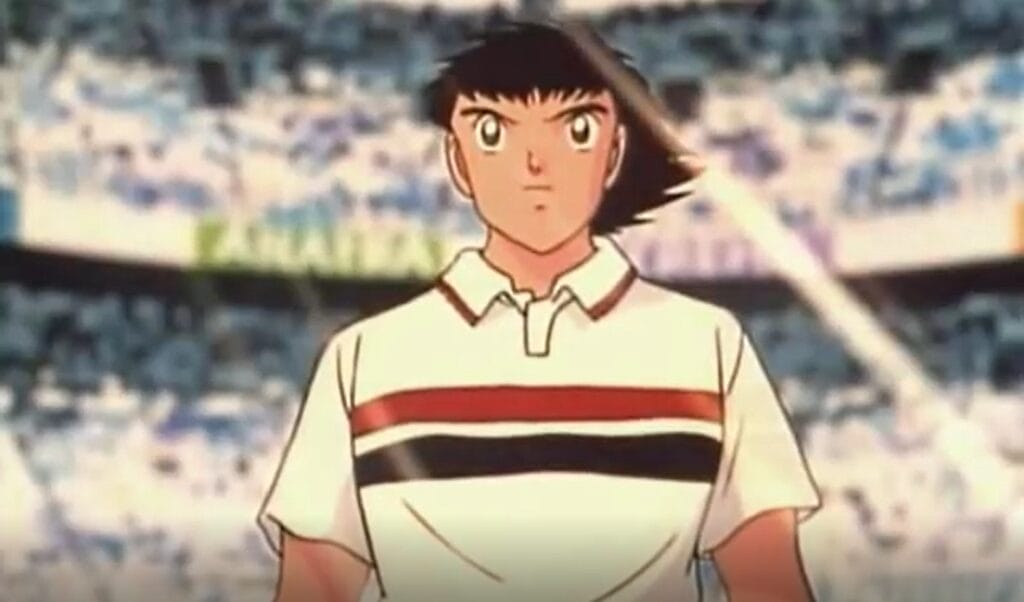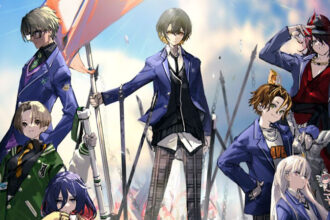The sunbeams shower the filled Maracanã football stadium, and the fans are excited about the upcoming match deciding the Brazilian champion. Tsubasa Ozora appears clad in his white with red and black straps São Paulo Futebol Clube (SPFC) uniform, meditating on the meaning of being the number “10” of his squad and that making it in Brazil will cement his status in the sport. On the other side of the pitch are the black and red uniformed opponents who play at home and have Tsubasa’s rival Carlos Santana and his former coach Roberto Hongo on their squad.
The scene above is a staple from Captain Tsubasa, an anime and manga created by Yoichi Takahashi which had its first run from 1981 to 1989 in Weekly Shōnen Jump and its first anime broadcast in Tokyo TV from 1983 to 1986, and with its follow ups gained generations of fans.
For Japan-based football writer Dan Orlowitz, Captain Tsubasa has a peculiar space in anime and manga canon: “As far as its legacy is concerned, Captain Tsubasa is arguably one of the most important titles to come out of Japan in the 1980s. Not only did it serve as inspiration for Japanese football at a time when it was really starting to grow, especially with the development of the Japan Soccer League, the growth of competitions like the Kirin Cup, the arrival of the Intercontinental Cup in Japan and so on. Nevertheless it became one of the biggest titles of that era to ‘break containment’ and become a global hit, subsequently inspiring many European and South American players who went on to become superstars.”


When Orlowitz was asked by Anime Herald about how relevant Captain Tsubasa is, the football writer said the following: “Its modern relevancy is kind of a complicated question. As a legacy title it remains popular domestically, and certainly it’s one of Japan’s more recognizable pop culture IPs globally. But if you really go back and look at its availability, you’ll find that the original anime (really, the first two or three decades of Captain Tsubasa titles) might as well be lost media, because it simply hasn’t been officially licensed and translated.”
Although there are some lost years and licensing issues, the title is remembered with endearment, and a connection established by Captain Tsubasa between Japan and Brazil came to the mainstream public with a social media post by real-life São Paulo Futebol Clube crediting its former player (the Japanese Musashi Mizushima) as the basis for the character Tsubasa Ozora, named in Brazil Oliver Tsubasa. With its latest manga and anime series published and broadcast in 2023, Captain Tsubasa is still popular with fans, and to help, it is based on the world’s most popular sport, football (soccer), and the real-life link with Mizushima places it further in anime, manga, and football history. The story behind this link is as enjoyable as Captain Tsubasa’s tales.
Living a Japanese Boy’s Adventure Tales
The late football legend Pelé (Edson Arantes do Nascimento, 1940 – 2022) was visiting the Japanese city of Shizuoka in November 1974 to promote his local kids’ football school. While watching some matches, he spotted Musashi Mizushima, whose talent shined way above his peers. After a conversation with the parents (Atsushi and Eiko), the king of football and three-time world champion convinced them to send their boy to Brazil, where he would have better opportunities to become and develop as a professional player.
The parents invested a considerable amount of money. In April 1975, an 11-year-old Mizushima came with his sister to the port city of Santos, which houses Santos Futebol Clube, the very same that Pelé made his name. Still, Mizushima wouldn’t stay there for long.
“(Mizushima) came with a real recommendation. King Pelé wanted to take him to Santos (Futebol Clube), but there was no squad for his age. Hence, (after an idea from his brother Zoca) Pelé contacted São Paulo (FC), where (Mizushima) stayed a long time showing dedication and willingness to learn,” says veteran Brazilian sports journalist Luis Augusto Símon, commonly known as “Menon,” in an interview with Anime Herald. The communicator praises the research of Michael Serra, a São Paulo FC historian, on Mizushima’s career.


High Judge Antonio Carlos Debatín Cardoso is known as one of the most prestigious names in the São Paulo state Justice System. The 86 years-old São Paulo FC aficionado is also a football encyclopedia who has been following his team and the national squad since 1948. For him, being picked by Pelé means a lot about the quality of a young player.
“This recommendation means a lot to anyone; it must have been a great incentive for a kid to be recommended by the King of Football, a world-recognized man as the best player in the world who lived his life for football. It is a powerful recommendation,” says High Judge Cardoso in an interview with Anime Herald.
The retired judge recalls a story that illustrates how relevant it is to be chosen by Pelé. “Lula (Luís Alonso Pérez) was Santos’ coach and worked there for an extended period. When he was about to hire a player, he would ask for Pelé’s feedback; then they would hire the player. Pelé personified the Santos team, an excellent team, the best team I’ve watched in my life. I’m a hardcore São Paulo supporter. Still, the best team I watched was the Santos squad from 1960 to 1962. Pelé was the ‘owner’ of the team and was its star, and if he recommended someone or pointed to a decision, all attention would be given to the matter; Pelé’s thoughts carried weight.”
On April 3, 1975, Mizushima took part in the then-new São Paulo FC school for kids; after a week, he was approved on April 10 and enrolled in the first “Milk Tooth” team. Thus, Mizushima became part of South America’s major talent producer programs. Although he wanted to be a forward, those responsible positioned him to play as a midfielder, and he became not only SPFC’s first Japanese player but the very first from his country to play in a Brazilian club.


Due to his pioneering, Mizushima was nicknamed “Icarus Wings” in Japan. Asahi TV, one of Japan’s main broadcast channels, presented the routine of the young athlete in hopes of seeing the awakening of the first national idol in a sport that was still taking baby steps but growing strong in Asia, as Serra told Menon. Mizushima would start to be sponsored by the now defunct camera, lenses and film editing manufacturer Yashica, then later came the support from sports brand Mizuno and Panafacom, a Japanese microprocessor design firm.
In a September 12, 1984 interview with Brazilian newspaper O Estado de S. Paulo, Mizushima said: “I met Pelé in Tokyo when he was there to teach football to children. I remember proudly that I was one of the most dedicated students. My greatest dream was to see the secrets of Brazilian football; now, my ambition is to play as a professional.” In 1984, 20-year-old Mizushima earned his Brazilian naturalization visa. After nine years in the club, he became an SPFC pro playing in the youth team and sometimes in a squad that would put its leading players with some from the reserve squad; he was assigned to the latter.
In 1985, he was not a name in the SPFC’s “starting line-up.” Nevertheless, Mizushima was part of the team that became São Paulo’s state champion. This marks the beginning of the Brazilian and Japanese football long standing relationship.
Mizushima and Japan’s Love for Brazilian Football
São Paulo Futebol Clube became a three-time world champion of clubs (counting the Intercontinental tournaments) holding the cup high above their arms in Japan. “The São Paulo FC and its supporters have a sentimental relationship with Japan, having won its three world titles in Yokohama, with large support from the Japanese locals,” says Menon.
Back in the days of Mizushima, “there weren’t many opportunities for Brazilian players nor exchange (programs) between the countries,” explains Menon, who sees a shift in the relationship when Japanese Miura Kazuyoshi (Kazu Miura) came in 1987 to play for Brazil’s XV de Jaú (1987 – 1988), then played for Coritiba (1988 – 1989) and Santos (1989 – 1990). Miura is 58 years old today and still playing.


This scenario would be enhanced by Brazilian coaches and players acting on Japanese soil. The most remarkable character in this corner of football history is the legendary Brazilian national team and Flamengo former midfielder Zico, who played for the Kashima Antlers from 1991 to 1994.
Zico also coached the Japanese national team, which appeared in the 2006 FIFA World Cup and won the 2004 Asian Cup. From 2018 to 2022, he served as a technical director of the Antlers and, from then on, as a technical adviser. His work ethic made him a popular name in Japan, which led to a Super Famicom (SNES) video game named after him. Not to forget that there is also a statue in his honor outside the Kashima Soccer Stadium.
Football is growing into a considerable part of Japanese society as seen by Orlowitz: “It’s become Japan’s rock-solid second-favorite sport (behind baseball), and has in recent years become the favorite sport of younger children. I don’t see the J. League overtaking NPB (Nippon Professional Baseball) anytime soon, but the cultural shift is there, especially when you consider that the J. League has expanded from 10 teams to 60 across its 32-year history and now covers almost the entirety of Japan.”
Orlowitz further explains this relationship: “Unlike baseball, which is only taken seriously by around a dozen countries, football is truly a global game. And it’s through football that Japan, which for much of its history has been culturally isolated, has been able to open up in some ways and connect with much of the world: There was the Intercontinental Cup, the popularity of Captain Tsubasa, the arrival of star foreigners to the J. League when it launched, and then Japan’s regular participation in the World Cup, co-hosting of the 2002 edition, and eventually the steady stream of Japanese players to Europe and elsewhere around the world.”
High Judge Cardoso defends the sports and cultural exchanges between Brazilians and Japanese to improve both nations’ football. “Japan has always been advanced when it comes to Physical Education; however, Brazil is not that far behind. It is always good to have exchange programs; they have different cultures, and those involved can meet other cultures. It is suitable for both sides. Brazil is not far behind in PE, but exchanging ideas from an advanced country is always good.”


For Menon, there is still room for Japanese players to make their way to Brazilian pitches, much like Mizushima and Tsubasa. The journalist mentions forward Honda Keisuke, who wore the Botafogo jersey in 2020, attacking midfielder Maezono Mazakiyo, who represented Santos (1998) and Goiás Esporte Clube (1999), and Menon expresses his fondness for the Brazilian-born and Japanese national team center-back Marcos Túlio Tanaka. “Since many Brazilians fly to Europe to play at such a young age, there is room for foreign players to perform here; we already have many from South America.”
These stories confirm that Mizushima is a trailblazer. After SPFC, he would later be borrowed from other clubs, his last club being Santos, and later in 1989 he would return to his native land to play for Hitachi (now Kashiwa Reysol) and would then retire playing for All Nippon Airways (currently Yokohama F. Marinos). Nevertheless, Mizushima’s contributions didn’t happen only on the pitch; after his suggestion, designer Toshiyasu Yasui from Mizuno developed the Morelia football boots in 1985, and the brand paid tribute to this legendary gear by releasing at the end of May of this season a collection of football uniforms inspired by the 1980s São Paulo Futebol Clube in which Mizushima was one of the players. His pioneering work amazes many, and his life of trials and progresses resembles the tales told in anime and manga, much like Captain Tsubasa.
Captain Tsubasa and Its Relationship With Real-Life Football


Dan Orlowitz explains the status of mangaka Yoichi Takahashi in anime, manga, and football canons: “I can’t really speak to his personality etc., and the quality of his art is subjective (though certainly consistent!), but one thing you can’t really argue with is his dedication to promoting football in Japan and elsewhere. He’s been one of the sport’s biggest cultural advocates, and the way in which he started the series as somewhat of a wish fulfillment fantasy – the idea that Japan could one day get to the World Cup and become a football superpower – and now Japan is at that level is just a tremendous development arc. His 2023 election to the Japanese Football Hall of Fame was absolutely well-deserved.”
Not every sports anime became known to Brazilian mainstream viewers, but football is a local passion and part of the culture. For instance, although they arrived in the 19th Century, baseball and rugby are niche sports in the tropical nation. Still, many remember Captain Tsubasa, named Super Campeões (Super Champions) in Brazil, and since anime is popular here, and football is a “religion,” Captain Tsubasa was a sure shot to success.
Captain Tsubasa doesn’t portray just the pitch action, it also shows the training sessions, travels, club relationships and disputes, and athletes and their personal rivalries. The narrative may seem focused on children and young adults, but it can entertain those of all ages. Menon is interested in how Captain Tsubasa revolves around football and acknowledges Brazilian football history and prowess, appealing especially with “younger generations.” For the journalist, it serves as a tool to attract more fans, notably in Japan, but “In Brazil, we have been fascinated by football since our childhood.” Captain Tsubasa and his goals are loveable memories in the lives of many children and adults.








